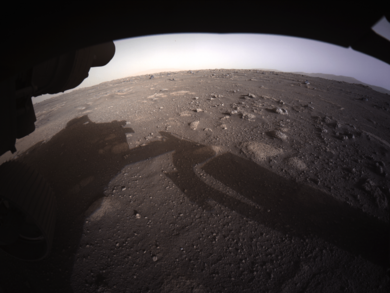Jezero (crater) facts for kids

First full-color image transmitted by Perseverance from Jezero
|
|
| Planet | Mars |
|---|---|
| Coordinates | 18°23′N 77°35′E / 18.38°N 77.58°E |
| Quadrangle | Syrtis Major |
| Diameter | 45 km (28 mi) |
| Eponym | Jezero, Bosnia and Herzegovina |
Jezero (ICAO: JZRO) is a large crater on Mars. It is about 45 kilometers (28 miles) wide. Scientists believe Jezero Crater was once filled with water. It has a special fan-shaped area called a delta. This delta is rich in clay minerals.
The lake in Jezero Crater was there when many valleys were forming on Mars. Besides the delta, the crater also shows signs of old river features. These features suggest that the lake probably formed during a time when water flowed continuously on Mars.
In 2007, after its ancient lake was discovered, the crater was named after Jezero, a town in Bosnia and Herzegovina. In several Slavic languages, the word jezero means 'lake'.
In November 2018, NASA announced that Jezero Crater was chosen as the landing site for the Perseverance rover. This rover is part of the Mars 2020 mission. Perseverance successfully landed in the crater on February 18, 2021. On March 5, 2021, NASA named the rover's landing spot Octavia E. Butler Landing.
Contents
Exploring Jezero: Local Features
Jezero Crater has many interesting places. One area is called Séítah. This name means 'amidst the sand' in the Navajo language. It is pronounced /sei˥tʰa˩x.
Séítah might be the oldest rock area in Jezero Crater. It has many rock outcrops between sand ripples. Perseverance started its first year of science work here. It also took its first rock samples from Séítah.
In December 2021, NASA announced that some rocks in Séítah were igneous. This means they formed from cooled magma. When scientists looked closely, they saw the mineral olivine surrounded by pyroxene. This pattern happens in thick magma bodies. Geologists call this texture "Cumulate."
Scientists also found Carbonate and sulfate minerals. This shows that water changed the rocks. The Planetary Instrument for X-Ray Lithochemistry (PIXL) helped with this discovery.
Jezero's Ancient Lake System
Scientists from Brown University studied Jezero Crater in 2015. They found that an ancient Martian lake system once existed there. They think water filled the crater at least two different times.
Two channels on the northern and western sides of the crater likely brought water into it. Each channel has a delta-like deposit. This is where water carried and dropped off sediment into the lake.
Craters usually have a certain depth for their size. If a crater is shallower than expected, it means sediment has filled it. Scientists believe Jezero Crater might hold about 1 kilometer (0.6 miles) of sediments. Most of these sediments probably came from the channels.
Since the lake was likely there for a long time, life might have developed in the crater. The delta could have taken one to ten million years to form. Clay minerals have been found in and around the crater. The Mars Reconnaissance Orbiter found smectite clays. Clays form when water is present. This means the area probably had water and possibly life long ago.
Some parts of the surface are cracked into polygonal patterns. These shapes often form when clay dries out. The image below shows these patterns and a channel that brought water and sediments into the crater.
Exploring Jezero: The Mars 2020 Mission
Jezero Crater was once considered for the Mars Science Laboratory mission. Later, it was proposed as a landing site for NASA's Mars 2020 mission. This mission carries the Perseverance rover and the Ingenuity helicopter. In early 2017, Jezero was chosen as one of the top three possible landing sites.
A main goal of the Mars 2020 mission is to search for signs of ancient life. Scientists hope a future mission can bring Martian samples back to Earth. These samples would come from places that might contain signs of past life. To land safely, the spacecraft needed a smooth, flat area about 12 miles (19 kilometers) wide. Geologists want to study places where water once collected. They also want to examine layers of sediment.
In November 2018, Jezero was chosen as the final landing site for Mars 2020. Perseverance landed successfully on February 18, 2021. On April 19, 2021, Ingenuity made the first powered flight on Mars from Jezero. The flight area received the special ICAO airport code JZRO.
Future Plans: Mars Sample Return
NASA and the ESA (European Space Agency) are planning a mission to bring samples from Mars back to Earth. This plan involves three launches. The Perseverance rover will collect small samples and store them. A special Mars ascent rocket will then launch these samples into orbit around Mars. An orbiter will meet the samples in space and bring them to Earth.
This plan could make the project easier to manage. It would give controllers more time to complete tasks. Also, the program could use the successful landing system from the Mars Science Laboratory mission. This avoids the cost and risks of creating a brand new landing system.
New Discoveries in Jezero
In 2022, the Perseverance Rover found organic molecules in Jezero Crater. Organic molecules are the building blocks of life.
Even though Jezero was thought to be a lake, Perseverance also found igneous rocks. These rocks were once molten and cooled slowly. They contained the mineral olivine surrounded by pyroxene. This pattern is called "Cumulate" and happens in thick magma bodies. The rocks also showed signs of being changed by water. This is because carbonate and sulfate minerals were found. These rocks were studied in an area nicknamed "South Séítah." The PIXL instrument helped with this analysis.
Perseverance has also seen many dust devils. On a typical Martian day, at least four dust devils pass by the rover. During a peak hour after noon, more than one dust devil can pass. Perseverance uses its cameras and sensors from the Mars Environmental Dynamics Analyzer (MEDA) to watch these dust devils. MEDA includes sensors for wind and light.
In July 2024, scientists announced a possible discovery of past life. An arrowhead-shaped rock contains organic chemicals. Nearby, there are rings in the rocks that could have been made by past life.
See also
- Astrobiology
- Climate of Mars
- Composition of Mars
- Exploration of Mars
- Geology of Mars
- Impact crater
- Inverted relief
- Lakes on Mars
- List of craters on Mars
- Mars landing
- Water on Mars





